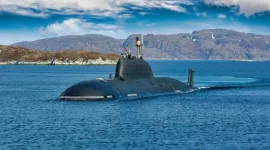- Views: 578
- Replies: 1

In a significant step towards bolstering its strategic defense capabilities, India is preparing to commission its second nuclear-powered submarine, the INS Arighat. This advanced vessel, equipped with nuclear missiles, is set to play a crucial role in maintaining a credible nuclear deterrence against potential adversaries.
The INS Arighat, a 6,000-ton submarine constructed at the Vizag shipyard, has successfully completed its trials and upgrades and is anticipated to be commissioned within the next two months. Upon joining the fleet, it will operate alongside the INS Arihant, India's first nuclear-powered submarine which has been in service since 2018.
This development comes at a time when India is also actively pursuing the construction of two additional nuclear-powered attack submarines armed with conventional weapons. These advancements underscore the country's determination to counter the expanding naval presence of China in the Indian Ocean region.
India's Expanding Submarine Fleet
The INS Arighat will be armed with K-15 missiles with a range of 750 km, similar to those deployed on the INS Arihant, but with an increased carrying capacity.Furthermore, the upcoming third SSBN, the INS Aridhaman, slated for commissioning next year, will be equipped with K-4 missiles boasting a range of 3,500 km.
The fourth SSBN, currently under construction, will have the capability to carry an even larger number of K-4 missiles. Future plans also include building larger 13,500-tonne SSBNs powered by advanced 190 MW reactors.
In addition to SSBNs, India is awaiting final approval for a project to build two nuclear-powered attack submarines (SSNs). These vessels, armed with torpedoes, anti-ship, and land-attack missiles, will be approximately 95% indigenous and are expected to take at least a decade to complete.
India's Strategic Vision
India aims to establish a robust submarine fleet comprising 18 diesel-electric submarines, four SSBNs, and six SSNs to effectively counter threats from China and Pakistan. Currently, the country possesses one SSBN, the INS Arihant, and 16 diesel-electric submarines.Larger SSBNs equipped with extended-range missiles will significantly enhance India's deterrence capabilities by providing secure platforms for guaranteed retaliatory strikes.
SSNs, renowned for their high speed and extended submerged operations, will also be vital in effectively targeting adversaries, unlike diesel-electric submarines that require regular surfacing.
In comparison, China boasts a fleet of around 60 submarines, including six Jin-class SSBNs armed with JL-3 missiles with a range of 10,000 km, and six SSNs.



